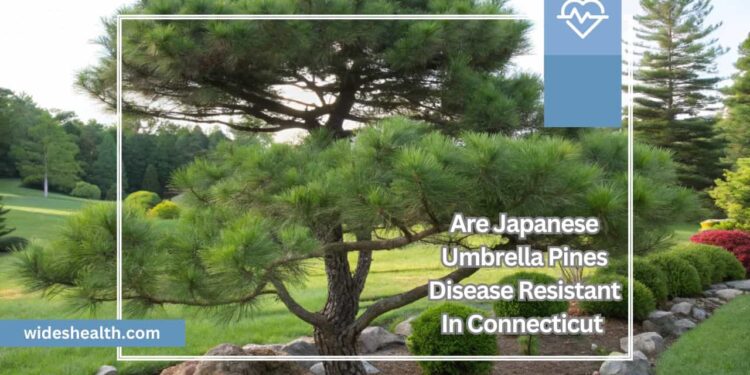If you’re searching for a beautiful, low-maintenance tree that adds a unique touch to your landscape, the Japanese umbrella pine (Sciadopitys verticillata) is a fantastic choice. This ancient species, dating back over 200 million years, stands out with its lush, needle-like foliage arranged in an umbrella shape.
One of its greatest advantages is its remarkable resistance to diseases and pests. But how well does it thrive in Connecticut’s climate? Is it truly disease-resistant in all conditions? Does it require special care to maintain its health? And what makes it a standout choice for New England gardens? Let’s explore these questions in detail.
Are Japanese Umbrella Pines Resistant to Disease in Connecticut?
Absolutely! One of the best things about the Japanese umbrella pine is its exceptional disease resistance.. Even in Connecticut’s humid summers and cold winters, it remains largely unaffected by common tree diseases.
Additionally, its thick, waxy needles provide a natural defense against fungal spores and pests. With proper care, such as well-drained soil and occasional pruning, this tree can thrive for decades. Whether planted in home gardens or public landscapes, it remains a reliable, disease-resistant choice for Connecticut gardeners.
Key Features of the Japanese Umbrella Pine:
- Ancient & One-of-a-Kind: This tree is a living fossil, surviving for over 200 million years with no close genetic relatives. Its unique lineage makes it a fascinating addition to any landscape, offering a rare glimpse into ancient plant evolution.
- Striking Evergreen Foliage: Unlike traditional pines, its dark green needle-like leaves grow in umbrella-shaped clusters, giving it a distinctive look. This evergreen beauty provides year-round color, making it a reliable focal point in any garden or landscape setting.
- Cold-Hardy & Resilient: Thrives in Connecticut’s climate (USDA Zones 5-7), tolerating harsh winters with proper wind protection. Its slow-growing nature ensures it remains manageable, making it ideal for both large and small spaces.
- Versatile for Landscaping: Perfect as a specimen tree, in rock gardens, or as part of foundation plantings. Its textured foliage adds depth and visual interest to both formal and casual landscapes, making it a versatile choice for homeowners.
- Eco-Friendly & Low-Maintenance: With natural resistance to pests and diseases, this tree requires minimal care and no chemical treatments. Its long lifespan, often spanning centuries, makes it a sustainable and environmentally friendly addition to any Connecticut garden.
Do Japanese Umbrella Pines Attract Pests?
Not at all! One of the biggest advantages of the Japanese umbrella pine is its natural resistance to pests. Unlike other evergreens that often struggle with aphids, borers, or scale insects, this tree remains largely pest-free.
Even better, it’s deer-resistant, which is a huge plus for gardeners in Connecticut, where deer can be a common problem. With its thick, waxy needles and strong structure, this tree doesn’t attract the usual pests that plague many other ornamental trees.
How Well Do Japanese Umbrella Pines Handle Connecticut’s Climate?
Japanese umbrella pines thrive in Connecticut because the state falls within USDA Zones 5-7, which perfectly match their hardiness needs. These trees handle cold temperatures well, but it’s best to plant them in a sheltered area to avoid damage from harsh winter winds.
With the right conditions—moist, well-drained soil and full sun—they can grow strong and healthy for generations. If properly cared for, they will continue to enhance the beauty of Connecticut landscapes year after year.
Also read: How To Become A Mental Health Volunteer In Baytown – Tips & Requirements!
What Soil Conditions Do Japanese Umbrella Pines Need?
To ensure the best growth, Japanese umbrella pines prefer moist, acidic, and well-drained soil. If your yard has clay-heavy soil, consider mixing in compost or organic matter to improve drainage.
Since these trees dislike waterlogged roots, it’s best to plant them in a slightly elevated spot to prevent excess moisture buildup. With the right soil conditions, this tree will flourish and maintain its stunning lush green foliage throughout the year.
Why Should You Plant a Japanese Umbrella Pine in Connecticut?
If you’re looking for a low-maintenance yet visually stunning evergreen for your Connecticut landscape, the Japanese umbrella pine (Sciadopitys verticillata) is an excellent choice. Here’s why:
Unique & Eye-Catching Appearance:
- The lush, needle-like foliage grows in an umbrella-like pattern, making it truly stand out.
- Its evergreen nature provides year-round greenery, adding beauty to your garden in every season.
- Unlike traditional pines, it has a distinctive texture that enhances any landscape design.
Naturally Disease & Pest-Resistant:
- This tree is highly resistant to common conifer diseases like needle blight and root rot.
- Unlike other evergreens, it rarely attracts pests like aphids, borers, or scale insects.
- No need for chemical treatments, making it a low-maintenance and eco-friendly choice.
Cold-Hardy & Long-Lived:
- Thrives in Connecticut’s climate, which falls within USDA Zones 5-7.
- Highly resistant to winter damage when planted in a sheltered location.
- With proper care, this ancient species can live for centuries, offering lasting beauty for generations.
Perfect for Landscaping & Garden Design:
- Works beautifully as a specimen tree, making it a stunning focal point in any garden.
- Ideal for rock gardens, foundation plantings, and formal landscapes, adding structure and elegance.
- Since it’s slow-growing and naturally shapely, it requires little to no pruning to maintain its beauty.
Do Japanese Umbrella Pines Need Special Care?
Not really! Japanese umbrella pines are incredibly low-maintenance, making them a great choice for busy gardeners. They only require weekly watering, with increased hydration during hot, dry months. A light application of fertilizer in early spring helps maintain their growth, but beyond that, they need minimal attention.
Unlike many other evergreens, this tree rarely requires pruning, as it naturally maintains an attractive shape. With just a little care, your Japanese umbrella pine will thrive effortlessly for years to come.
Are Japanese Umbrella Pines Suitable for Landscaping in Connecticut?
Absolutely! Japanese umbrella pines are a fantastic addition to Connecticut gardens. Their lush, year-round greenery makes them an excellent focal point, whether planted as a specimen tree, in a rock garden, or near a foundation.
Unlike other ornamental trees that require constant upkeep, this one is disease and pest-resistant, making it a hassle-free choice. Whether you’re designing a formal landscape or a natural woodland garden, this tree adds timeless beauty with minimal maintenance.
Benefits of Japanese Umbrella Pines:
Exceptional Disease & Pest Resistance:
- Naturally resistant to common tree diseases like needle blight and root rot, reducing the need for chemical treatments.
- Unlike many other evergreens, it rarely attracts harmful pests such as aphids, borers, or scale insects, ensuring minimal maintenance.
- This strong resistance helps the tree stay healthy year-round, even in Connecticut’s fluctuating climate.
Thrives in Connecticut’s Climate:
- Well-adapted to USDA Zones 5-7, making it an ideal choice for Connecticut’s cold winters and humid summers.
- Tolerates freezing temperatures but benefits from some wind protection to avoid needle burn in harsh winters.
- With proper watering, well-drained soil, and full sun, it flourishes beautifully with little effort.
Unique & Striking Decorative Foliage:
- Features umbrella-like clusters of glossy green needles, creating an exotic and eye-catching appearance.
- Unlike deciduous trees that lose leaves in winter, this evergreen retains its lush green color year-round, making it a focal point in any landscape.
- Its slow-growing nature ensures it maintains a neat and structured shape without frequent pruning.
Also read: How Does Rising Morbidity Rates Affect Health Insurance – Avoid Higher Costs!
Low-Maintenance & Exceptionally Long-Lived:
- Requires minimal pruning, as it naturally develops an elegant form over time.
- Unlike fast-growing trees that require frequent trimming, it grows slowly but steadily, maintaining its beauty for generations.
- Known to live for centuries, making it an excellent long-term investment for any garden or estate.
Environmentally Friendly & Sustainable:
- Since it is naturally resistant to pests and diseases, it doesn’t require harmful pesticides or chemical treatments.
- Acts as a natural air purifier, absorbing pollutants and improving air quality in urban and suburban areas.
- Helps in biodiversity conservation, as its presence supports a healthy and balanced ecosystem without the need for excessive intervention.
With these outstanding benefits, the Japanese umbrella pine is a perfect addition to Connecticut landscapes, offering durability, beauty, and sustainability all in one tree.
Can Japanese Umbrella Pines Tolerate Harsh Connecticut Winters?
Yes, but with a little protection. While Japanese umbrella pines are cold-hardy, they can suffer from needle burn due to strong winter winds. To prevent damage, plant them in a sheltered location, apply mulch around the base to insulate the roots, and consider using burlap wrapping in extreme cold. With these simple precautions, your tree will stay healthy and vibrant throughout Connecticut’s winter months and emerge stronger in spring.
How Long Do Japanese Umbrella Pines Live?
Japanese umbrella pines have an impressively long lifespan, often surviving for hundreds of years. Their slow growth and durable nature make them an excellent long-term investment for any landscape. If you want a tree that will stand the test of time, this ancient species is a perfect choice.
With the right conditions, it will continue to grow and thrive, offering its stunning, evergreen beauty to generations of homeowners and garden enthusiasts in Connecticut and beyond.
Future Potential of Japanese Umbrella Pines in Connecticut:
As more homeowners and landscapers seek unique, resilient trees, the Japanese umbrella pine is gaining popularity in Connecticut gardens. Its low-maintenance beauty makes it a favorite among landscape designers, while researchers continue to study its adaptability to climate changes.
With increasing urban greenery initiatives, this pollution-resistant tree is a great fit for parks and public spaces. Additionally, horticulturists may develop improved cold-resistant cultivars for wider use. Even in smaller spaces, its slow growth makes it a perfect bonsai or container plant, expanding its future possibilities.
FAQS:
Are Japanese umbrella pines truly disease-resistant in Connecticut?
Yes! Japanese umbrella pines have strong natural resistance to common tree diseases like needle blight and root rot. Even in Connecticut’s humid summers and cold winters, they remain healthy without requiring chemical treatments, making them a low-maintenance and reliable choice for gardeners.
How fast does a Japanese umbrella pine grow?
This tree is a slow grower, typically adding 6–12 inches per year. While this may seem slow, its longevity (living for centuries) makes it a worthwhile investment for landscapes. Its manageable size also means it won’t outgrow small garden spaces too quickly.
Do Japanese umbrella pines need protection in winter?
While they are cold-hardy (USDA Zones 5-7), strong winter winds can sometimes cause needle burn. To prevent damage, plant them in a sheltered spot, apply mulch to insulate the roots, and consider using a burlap wrap during extremely harsh winters.
Can Japanese umbrella pines be grown in pots or containers?
Yes, but with care! Their slow growth makes them suitable for large containers, but they need moist, well-drained soil and occasional repotting as they grow. Container-grown trees may require extra winter protection since pots expose roots to colder temperatures.
What makes Japanese umbrella pines different from other evergreens?
Unlike typical pines, they have no close relatives, making them a one-of-a-kind species. Their umbrella-like needle clusters give them a distinct look, and their disease resistance sets them apart from other conifers that often struggle with pests and fungal infections.
Conclusion:
The Japanese umbrella pine is a rare and disease-resistant evergreen that thrives in Connecticut’s climate. Its striking foliage, natural pest resistance, and low-maintenance needs make it a perfect choice for homeowners and landscapers. This ancient species adds year-round beauty while requiring minimal care. With its ability to withstand harsh winters, this tree remains a long-lasting and sustainable investment.
As interest in durable, eco-friendly trees grows, the Japanese umbrella pine continues to stand the test of time in Connecticut gardens. Whether used as a focal point in a landscape or planted for its historical significance, this tree never fails to impress. Its unique beauty and resilience make it a true treasure for generations to come.









